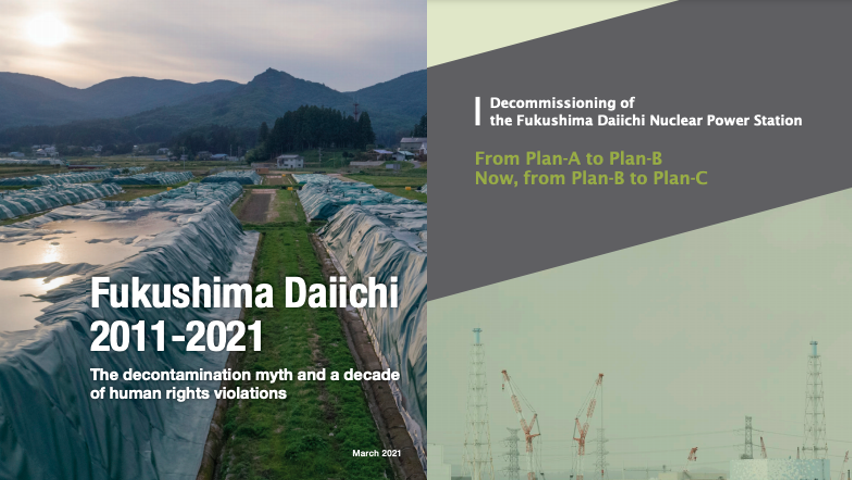
Mar 4, 2021 (Greenpeace Japan) – Nearly a decade after the Fukushima Daiichi nuclear accident, Greenpeace released two reports today that highlighted the complex legacy of the 11 March 2011 earthquake and tsunami.
The first report Fukushima 2011-2020 detailed radiation levels in Iitate and Namie in Fukushima prefecture. Our original findings showed that decontamination efforts have been limited and that 85% of the Special Decontamination Area has undergone no decontamination.
The second report Decommissioning of the Fukushima Daiichi Nuclear Power Station From Plan-A to Plan-B Now, from Plan-B to Plan-C critiqued the current official decommission plan within 30-40 years of having no prospects of success and is delusional.
“Successive governments during the last ten years, and largely under prime minister Shinzo Abe, have attempted to perpetrate a myth about the nuclear disaster. They have sought to deceive the Japanese people by misrepresenting the effectiveness of the decontamination program and ignoring radiological risks,” said Shaun Burnie, Senior Nuclear Specialist at Greenpeace East Asia.
“At the same time, they continue to claim that the Fukushima Daiichi site can be returned to ‘greenfield’ status by mid-century. The decade of deception and delusion on the part of the government and TEPCO must end. A new decommissioning plan is inevitable so why waste any more time with the current fantasy?” Burnie added.
The first Greenpeace radiation expert team arrived in Fukushima prefecture on 26 March 2011, and have conducted 32 investigations into the radiological consequences of the disaster over the last decade, the most recent in November 2020. The key findings of the radiation report Fukushima 2011-2020 are:
- Greenpeace has consistently found that most of the 840 square kilometers Special Decontamination Area(SDA), where the government is responsible for decontamination, remains contaminated with radioactive cesium.
- Analysis of the government’s own data shows that in the SDA an overall average of only 15% has been decontaminated.
- No time frame for when the Japanese government’s long-term decontamination target level of 0.23 microsieverts per hour (μSv/h) will be achieved in many areas. Citizens will be subjected for decades of radiation exposure in excess of 1mSv/y recommended maximum.
- In the areas where evacuation orders were lifted in 2017, specifically, Namie and Iitate, radiation levels remain above safe limits, potentially exposing the population to increased cancer risk. Plans to continue to lift evacuation orders are unacceptable from a public health perspective.
- Up till 2018, tens of thousands of decontamination workers had been employed in decontamination in the SDA. As documented by Greenpeace[1], the workers, most of whom are poorly paid subcontractors, have been exposed to unjustified radiation risks for a limited and ineffective decontamination program.
The key findings of The Fukushima Daiichi Nuclear Power Station decommissioning report[2] are:
- There are no credible plans for retrieval of the hundreds of tons of nuclear fuel debris remaining inside and under the three Reactor Pressure vessels – it requires a fundamental review.
- Water used in reactor cooling and groundwater contamination, and therefore accumulating in tanks, will keep growing into the future unless a new approach is adopted.
- All nuclear contaminated material should remain on the site indefinitely. If the nuclear fuel debris is ever retrieved, it also should remain on site. Fukushima Daiichi is already and should remain a nuclear waste storage site for the long term.
- The current plan is unachievable in the timeframe of 30-40 years in the current road map and impossible to achieve in terms of returning the site to greenfield.
It is recommended that a fundamental rethink in approach and a new plan for the decommissioning of Fukushima Daiichi, including a delay in molten fuel removal for 50-100 years or longer is needed with the construction of secure containment buildings for the long term. The Primary Containment vessel, with reinforcement, should be used as an incomplete primary boundary and the reactor building as the secondary boundary for the medium-to-long term, while developing robotic technology that can perform tasks without high radiation risks to human workers.
Finally, to prevent the further increase of radioactive contaminated water, cooling of nuclear fuel debris should be switched from water to air cooling, and the Fukushima Daiichi site should be made into a ‘dry island’ isolated from groundwater with the construction of a deep moat.
ENDS
Links to full reports:
- Fukushima 2011-2020
- Decommissioning of the Fukushima Daiichi Nuclear Power Station From Plan-A to Plan-B Now, from Plan-B to Plan-C
- Greenpeace Briefing “Fukushima Daiichi Decommissioning Time for a new long term strategic plan”
Notes:
[2] Report commissioned by Greenpeace from a consulting nuclear engineer, formerly with General Electric including at the Fukushima Daiichi reactors, Mr. Satoshi Sato.
